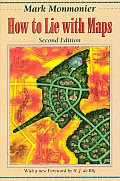
| Publisher: | University of Chicago |
| Copyright: | 1991, 1996 |
| Printing: | 1996 |
| ISBN: | 0-226-53421-9 |
| Format: | Trade paperback |
| Pages: | 189 |
I loved the idea of this book the first time I heard about it. Inspired by How to Lie with Statistics, this book tries to do the same for cartography. Maps have to lie: as a scaled-down representation of a complex reality, a flattened 2D projection of 3D space, and often a planar projection of a spherical surface, they necessarily omit detail and distort the territory. Monmonier provides an introduction to the competing principles used to choose simplifications, common techniques for maintaining important information at smaller scales, and some of the ways maps can be used to distort and give erroneous impressions.
Unfortunately, there are a few problems with this treatment of the subject, the largest of which is that this book feels very dated. Statistics is an easier topic in that sense. Statistics is still roughly the same as it was twenty years ago. Cartography, on the other hand, has gone from frequently black and white to always color, has been completely revolutionized by computers, and has now been turned on its head by Google Maps, and most of these changes are too new to be adequately dealt with here. I did read the revised second edition, and Monmonier tried to provide some updates, but 1996 is an eternity ago for anything affected by computers. The chapter on interactive exploration of maps via computers tries very hard and manages to still be mildly interesting, but it's a little like reading a comparison between slide rules and four-function calculators.
A related problem is the lack of color. This too has been partly addressed in the second edition, but the color plates that were added are extremely basic and simplistic, and frankly rather ugly. One of the fun parts about reading a book like this is enjoying the beautiful artwork done by cartographers who truly know what they're doing, but there's very little of that here and none of it in the color area. I'm afraid it suffers badly in comparison to Edward Tufte's work.
Still, there are fascinating tidbits. The information on how national mapping projects are done was mostly new to me, as were the details on transformations of maps at different scales and the editing process that goes into producing a map. I enjoyed reading about the problems with finding authoritative information for street maps and some of the examples of mistakes that were surprisingly difficult to correct. Monmonier also highlights points that are obvious in retrospect but whose implications I'd not thought through, such as the choice of breaks between grey-scale or color gradients and the way they can completely change the apparent information of a map, or the huge difference between graphing magnitude and graphing density when displaying that information on spacial grids. Tufte covers some of this material better, but not all of it.
While the tone is occasionally a bit snarky, it's not as funny or as biting as I would have wished. I did read it between two books by Nassim Nicholas Taleb, a remarkably hard act to follow, but Monmonier is just a bit too nice to having me laughing at most of his analysis. He does have his moments, though, the best of which is the chapter on development maps and seducing the town board. That I expect has aged quite well.
Overall, I would recommend this book, but with caveats, and I'm not sure it's worth paying full price for (as opposed to looking for it in your local library). You'll learn things from it, but you'll also have to page through a lot of obsolete analysis, and the book is sadly far from being a feast for the eyes. An updated edition for the Google Maps era that's full color throughout and includes some of the spectacularly beautiful examples that Tufte finds would be very welcome.
Reviewed: 2008-05-05